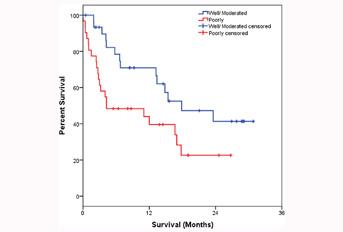Associação Portuguesa de Investigação em Cancro
High systemic IL-6 is associated with worse prognosis in patients with non-small cell lung cancer
High systemic IL-6 is associated with worse prognosis in patients with non-small cell lung cancer

Autores e Afiliações:
Estela Maria Silva1#, Vânia Sammartino Mariano1#, Paula Roberta Aguiar Pastrez1, Miguel Cordoba Pinto2, António Gil Castro3,4, Kari Juhani Syrjanen5, Adhemar LongattoFilho1,3,4,6
1 Teaching and Research Institute, Barretos Cancer Hospital–Pio XII Foundation, Barretos, Sao Paulo, Brazil,
2 Department of Chest, Barretos Cancer Hospital–Pio XII Foundation, Barretos, Sao Paulo, Brazil,
3 Research Institute of Life and Health Sciences (ICVS), University of Minho, Braga, Portugal,
4 ICVS / 3B’s —Associated Laboratory to the Government of Portugal, Braga / Guimarães, Portugal,
5 Department of Clinical Research—Biohit Oyj, Helsinki, Finland,
6 Medical Laboratory of Medical Investigation (LIM) 14, Department of Pathology, Faculty of Medicine, University of São Paulo, Sao Paulo, Sao Paulo, Brazil
# These authors contributed equally to this work.
Abstract:
Characteristic cytokine patterns have been described in different cancer patients and they are related to their diagnosis, prognosis, prediction of treatment responses and survival. A panel of cytokines was evaluated in the plasma of non-small cell lung cancer (NSCLC) patients and healthy controls to investigate their profile and relationship with clinical characteristics and overall survival. The case-controlled cross-sectional study design recruited 77 patients with confirmed diagnosis of NSCLC (cases) and 91 healthy subjects (controls) aimed to examine peripheral pro-inflammatory and anti-inflammatory cytokines (IL-2, IL-4, IL-6, IL-10, IL-17A, TNF and IFN-γ) by Cytometry Beads Arrays (CBA Flex) in. The cytokine IL-6 showed a statistically significant difference among groups with increased expression in the case group (p < 0.001). The correlation between the cytokines expression with patient’s clinical characteristics variables revealed the cytokine IL-6 was found to be associated with gender, showing higher levels in male (p = 0.036), whereas IL-17A levels were associated with TNM stage, being higher in III–IV stages (p = 0.044). We observed worse overall survival for individuals with high levels of IL-6 when compared to those with low levels of this cytokine in 6, 12 and 24 months. Further studies of IL-6 levels in independent cohort could clarify the real role of IL-6 as an independent marker of prognostic of NSCLC.
Revista: Plos One
Link: http://journals.plos.org/plosone/article?id=10.1371/journal.pone.0181125




